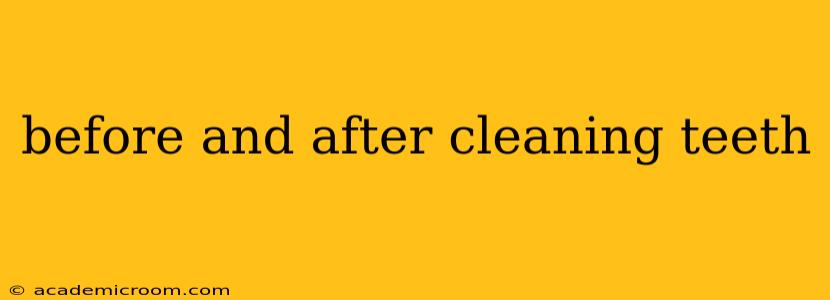Maintaining optimal oral health is crucial for overall well-being. Understanding the stark differences between a mouth before and after a thorough cleaning highlights the importance of consistent dental care. This guide delves into the key aspects of oral hygiene, providing insights into what to expect before and after cleaning your teeth, and addressing frequently asked questions.
What Does My Mouth Look Like Before Cleaning?
Before cleaning, your mouth might exhibit several signs depending on your oral hygiene practices. These could include:
- Visible Plaque: A sticky, colorless film of bacteria that accumulates on your teeth. It's the primary culprit behind cavities and gum disease. You might see it as a slightly hazy film, especially along the gum line.
- Food Debris: Leftover food particles lodged between teeth or on the surface. This is particularly noticeable after consuming sticky or sugary foods.
- Bad Breath (Halitosis): Bacteria breaking down food particles produce volatile sulfur compounds, leading to unpleasant breath odor.
- Stained Teeth: Depending on your diet and habits (coffee, tea, smoking), your teeth might appear discolored or stained.
- Gum Inflammation (Gingivitis): Inflamed gums might appear red, swollen, and bleed easily when brushing. This is an early sign of gum disease.
What Happens During the Cleaning Process?
Cleaning your teeth involves more than just brushing. A comprehensive approach includes:
- Brushing: Using fluoride toothpaste and a soft-bristled brush, gently brush all tooth surfaces for at least two minutes, twice a day. Focus on the gum line.
- Flossing: Flossing removes food particles and plaque from between teeth where your toothbrush can't reach.
- Rinsing: Using an antimicrobial mouthwash can help eliminate lingering bacteria and freshen your breath.
What Does My Mouth Look Like After Cleaning?
After a thorough cleaning, your mouth should feel and look significantly different:
- Clean Teeth: Your teeth will appear smoother, brighter, and free of visible food debris and plaque.
- Fresh Breath: The removal of bacteria significantly reduces bad breath.
- Healthy Gums: Your gums should appear pink, less inflamed, and less likely to bleed.
- Improved Taste: Your mouth will feel cleaner and your sense of taste will be enhanced.
How Often Should I Clean My Teeth?
You should brush and floss your teeth at least twice a day, ideally after breakfast and before bed. Regular professional cleanings by a dentist are also crucial, typically recommended every six months.
What if I Still Have Bad Breath After Cleaning?
Persistent bad breath, even after cleaning, could indicate underlying medical conditions or poor oral hygiene practices. Consult your dentist or physician to rule out any underlying issues.
Can I Whiten My Teeth at Home?
Many at-home whitening products are available, but it's crucial to choose products recommended by your dentist to avoid damaging your enamel.
What Are the Long-Term Benefits of Good Oral Hygiene?
Consistent oral hygiene significantly reduces your risk of developing serious oral health problems like cavities, gum disease (gingivitis and periodontitis), and even impacts overall health by reducing the risk of heart disease and other systemic issues.
Conclusion
The difference between a mouth before and after proper cleaning is dramatic. By following a consistent oral hygiene routine and scheduling regular dental checkups, you can maintain healthy teeth and gums for a lifetime. Remember, prevention is key to a bright, healthy smile!
